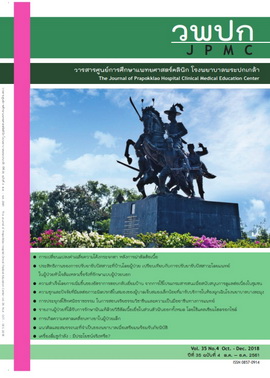Efficacy of Home-adjusting diuretic compared with Office-adjusting diuretic in Chronic Heart Failure Patients
Main Article Content
Abstract
Background: Diuretic self-adjustment at home has become widely used in many countries among chronic heart failure (CHF) patients, but its use is still new to Thailand.
Objective: To compare diuretic self-adjustment at home versus office-adjusted diuretic, including number of visits to the emergency department (ED) or out patient department (OPD), hospitalization, and mortality rate.
Design: A randomized control trial was conducted at Abhaiphubejhr Hospital in Thailand. Participants were 91 CHF patients, who were assigned into either the home diuretic self-adjustment group (experimental group) or the hospital office-adjusted diuretic group (control group). All participants were monitored for six months. (control group). All participants had been follow up for six months.
Results: Among 91 patients recruited over one year, 45 patients were assigned into the experimental group and the other 46 patients into the control group. Numbers of visits to the ED or OPD were 18 among 10 patients in the experimental group compared to 11 among 10 patients in the control group, which was not a statistically significant difference (p = 0.352). There was a statistically significant difference between hospitalization rates with the experimental group having fewer – 10 hospitalizations in the control group (21.7%) compared to 4 hospitalizations in the experimental group (8.8%) (p = 0.042). No mortality events occurred in the experimental group while there were five deaths in the control group (10.9%) (p = 0.014)
Conclusion: Among patients with CHF, the home diuretic self-adjustment group had lower mortality and hospitalization rates compared to the office-adjusted diuretic group. However, there was no statistically significant difference in the number of visits to the ED or OPD.
Article Details
References
1.McMurray JJ, Adamopoulos S, Anker SD, Auricchio A, Bohm M, Dickstein K, et al. ESC guidelines for the diagnosis and treatment of acute and chronic heart failure 2012: The task force for the diagnosis and treatment of acute and chronic heart failure 2012 of the European Society of Cardiology. developed in collaboration with the Heart Failure Association (HFA) of the ESC. Eur J Heart Fail 2012;14:803-69.
2. Jiang H, Ge J. Epidemiology and clinical management of cardiomyopathies and heart
failure in China. Heart. 2009;95:1727-31.
3. Kannel WB. Incidence and epidemiology of heart failure. Heart Fail Rev 2000;5:167-73.
4. Lam CS, Donal E, Kraigher-Krainer E, Vasan RS. Epidemiology and clinical course of heart
failure with preserved ejection fraction. Eur J Heart Fail 2011;13:18-28.
5. Mosterd A, Hoes AW. Clinical epidemiology of heart failure. Heart 2007;93(9):1137-46.
6. Remme WJ, Swedberg K. Guidelines for the diagnosis and treatment of chronic heart
failure. Eur Heart J 2001;22:1527-60.
7. Meyer P, White M, Mujib M, Nozza A, Love TE, Aban I, et al. Digoxin and reduction of heart
failure hospitalization in chronic systolic and diastolic heart failure. Am J Cardiol 2008;102:
1681-6.
8. Aronow WS. Epidemiology, pathophysiology, prognosis, and treatment of systolic and
diastolic heart failure.Cardiology in review. 2006;14:108-24.
9. Costanzo MR, Jessup M. Treatment of congestion in heart failure with diuretics and
extracorporeal therapies: effects on symptoms, renal function, and prognosis. Heart Fail
Rev 2012;17:313-24.
10. Leto L, Aspromonte N, Feola M. Continuous infusion versus bolus injection of loop diuretics in acute heart failure: a literature review. G Ital Cardiol (Rome) 2012;13:263-72.
11. Wright SP, Walsh H, Ingley KM, Muncaster SA, Gamble GD, Pearl A, et al. Uptake of self-
management strategies in a heart failure management programme. Eur J Heart Fail 2003;
5:371-80.
12. DeWalt DA, Malone RM, Bryant ME, Kosnar MC, Corr KE, Rothman RL, et al. A heart failure
self-management program for patients of all literacy levels: a randomized, controlled
trial [ISRCTN11535170]. BMC Health Serv Res 2006;6:30.
13. Riegel B, Driscoll A, Suwanno J, Moser DK, Lennie TA, Chung ML, et al. Heart failure self-
care in developed and developing countries. J Card Fail 2009;15:508-16.
14. Jones CD, Holmes GM, Dewalt DA, Erman B, Broucksou K, Hawk V, et al. Is adherence to
weight monitoring or weight-based diuretic self-adjustment associated with fewer heart
failure-related emergency department visits or hospitalizations?. J Card Fail 2012;18:576-
84.
15. Prasun MA, Kocheril AG, Klass PH, Dunlap SH, Piano MR. The effects of a sliding scale
diuretic titration protocol in patients with heart failure. J Cardiovasc Nurs 2005;20:62-70.

